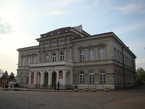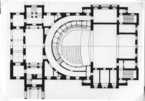Hanka‘s House
Václav Kaura
Hankův dům | |
| show on the map | http://www.hankuv-dum.cz/ |
Important events
The foundation stone was laid during a celebration on 29th of September of 1867. Architect Schulz submitted designs of the theatre in the following year in a form of a one storey building with an entrance bay with a high arched niche and an expression in a folkloric manner.
The first more extensive reconstruction of the hall and the entire Hanka’s House was carried out in 1904 -1905, the design was probably delivered by Jindřich Lorenc. The original curtain with a painted veduta of the city and scenes of its selected monuments, created by local amateur actor Václav Hanibal, was replaced for a new one that was created by painter Vladimír Županský on the motif of the poem “Jelen” from the Manuscript of Dvůr Králové in the first years of the 20th century as well.
People
He belongs among the most known architects of the Czech Neo Renaissance architecture. He was a co-worker and continuator of J. Zítek by building the Rudolfinum and completion of the National Theatre after the fire. His man work – the National Museum – was build according to Viennese museums and the Louvre in Paris as a truly representative (although not very functional) national monument. He topped his work off with construction of the Museum of Decorative Arts in Prague. He was a versatile architect and designer, although rather not much original in comparison with the talent of Zítek. However, his main buildings are considered the showpieces of Czech architecture, on which famous sculptors and painters worked as well – the so called generation of the National Theatre. As an outstanding pedagogue, he influenced the entire generation of his disciples.
Text: ing arch Kamil Dvořák, DrSc, in: Architekti v českých zemích (Prostor – AD)
More theatresHistory
A first stage to amateur theatre, that was staged in the city at the beginning of the 19th century in Umlauf inn (N. 44) on the square and that were directed by Čeněk Brož, was lent and Passion plays, which were being produced in one of the neighboring houses between 1812 – 1817. Dvůr Králové amateur actors played later in so called “Svobodovský Hall“, which was located in the northern frontage of the square ( in the location of an Art Nouveau building of Spořitelna). A place for theatre productions was as well the hall of the Šuppich’s inn on the suburb and timber Hanka’s inn with the Lorenz’s hall (it was of a layout of an oblong building opened by fours high windows, topped by semicircular arches, on the street frontage and covered by a saddle roof according to the drawing from 1868 in the municipal annals), torn down in 1874 not long before the completion of the present Hanka’s House. The permanent provisional measures led the theatrical association to considering construction of a new theatre building. After Václava Hanka had died, the chairman of the Dvůr Králové theatrical association Antonín Kadlec formed a board in 1861 that adopted a decision to construct the Hanka’s House for “ celebration of Hanka and for amelioration of the city of Dvůr Králové”. A financial basis for realization of this intent should have been gathered from public collections, a building material was promised to be delivered by the city and other corporations (the municipal brewery) apart of financial support.
Representatives of the association were negotiating design of the intended structure with prominent Prague architects: unsuccessfully with Ignác Vojtěch Ulmann, later with a better result with Josef Zítek and Josef Schulz, who accepted the assignment, but wartime events delayed the issue. The city then took over the responsibility and decided to lay the foundation stone by a celebration on 29th of September as well. Architect Schulz submitted designs of the theatre in the following year (in a form of a one storey building with an entrance bay with a high arched niche, an expression in a folkloric manner of gables and parts with loggias on the sides of the building) with costs that should not have exceeded an amount of 10 000 Guldens. However, an unfavourable economic situation postponed the execution of the construction up to the spring of 1873 when foundation excavation begun in April. Architect Schulz could not pursue required alteration of the original design due to his work load at the construction of the National Theatre, therefore the city decided to assign the final design to Prague architect Václav Kaura with a condition that the construction cost would not exceed the sum of 20 000 Guldens and its execution then to builder Robert Herkner. Construction continued throughout the rest of the year 1873 and subsequently in the spring of 1874 in a high speed that was not slowed down by concerns of a low bearing capacity of the grand gallery of the theatre hall and critique of its little grandeur, which was heard from citizens of Dvůr Králové. The entire Neo Renaissance construction of the Hanka’s House was already roofed by July of 1874 and was heading towards the ceremonial opening that took place on 27th of September. The total costs more than doubled against the originally intended sum and it burdened the city for a long period of time with instalments. Even the author Kaura had to sue the city for his fee. After the National Theatre in Prague had burnt down in 1881, anti fire measures were increased in the hall and theatre rooms of the Hanka’s House. In the summer of 1885, the local authority was considering the necessity of repairing the hall ceiling, which main beams seemed to be bended so it “could slump one day”.
The first more extensive reconstruction of the hall and the entire Hanka’s House was carried out not until 1904 -1905 with total expenses of 31 000 Crowns (the design was probably delivered by Jindřich Lorenc, a police commissioner at that time). Dvůr Králové photographer J. Rublič depicted on his photographs the appearance of the oblong hall of that time, framed by arcades on both the sides, above which projecting galleries jutted out on decorative vegetable corbels. The original curtain with a painted veduta of the city and scenes of its selected monuments, created by local amateur actor Václav Hanibal, was replaced for a new one that was created by painter Vladimír Županský on the motif of the poem “Jelen” from the Manuscript of Dvůr Králové in the first years of the 20th century.
The city was solving by the possible reconstruction of the Hanka’s House already during the First World War; however, nothing had been accomplished from the design, elaborated by local architect Karl Jarolímek. Another adaptation was being considered in the 1920s by which a cinema should have been established in the building; other minor reconstructions of the building occurred in wartime years 1940- 1945 (Dvůr Králové saving bank had more than million fund ready from its profits for the construction of a new theatre building in 1938, it was expropriated by the Third Reich under occupation).
An extensive reconstruction of the Hanka’s House occurred after the Second World War in 1969 – 1975 that has affected all the room in the structure (it scratched out the original historicising character from some of them; other monumentally valuable elements disappeared completely, for instance a little garden on the roof). A restaurant came into existence in the building basement, the attic room was adapted into a club. The last reconstruction of the Hanka’s House was carried out in 2003-2004.
Literature:
- Antonín K. Viták, Dějiny královského věnného města Dvora Králové nad Labem. Dvůr Králové 1867.
- Josef Matys, Umělecké památky okresu královédvorského z XIX. a XX. století, Pod Zvičinou X, 1935, č. 9-10, s. 66.
- Rudolf Fiala, Naše Hankovo divadlo. Dvůr Králové 1984.
- Jiří Hilmera, Česká divadelní architektura. Praha 1999, s. 33-35, 51, 168.
- Z městské pamětní knihy Bedřicha Söllnera: 130 let Hankova divadla, Dvůr Králové nad Labem. Vlastivědné čtení o našem městě i jeho okolí, Ř. 3, 2004, č. 6, s. 2-3
- Milena Martincová - Zuzana Čermáková, Rekonstrukce Hankova domu, Dvůr Králové nad Labem. Vlastivědné čtení o našem městě i jeho okolí, Ř. 3, 2004, č. 6, s. 10-14.
- Hankův dům a další rukopisné památky ve Dvoře Králové nad Labem. Dvůr Králové nad Labem 2004.
Tags: Austria-Hungary, Neo-Renaissance, Belle Époque, detached building, prestige building
Author: Pavel Panoch
Pavel Panoch:
City Theatre of J.K. Tyl, Karel Pippich Theatre, Tyl's Theatre Lomnice nad Popelkou, Hálek Town Theatre Nymburk, Dr. Josef Čížek Town Theatre Náchod, East Bohemia Theatre Pardubice, Fráňa Šrámek Theatre Písek, Kolár's Theatre, Tyl's House in Polička, Alois Jirásek Theatre, Jirásek Theatre Hronov, Municipal Theatre in Broumov, J. K. Tyl`s Theatre, Dusík Theatre Čáslav, Hanka‘s House, Klicpera's theatre Hradec Králové, Diviš Theatre, Pardubice Competition 1961-1962, Cinema the Czech Paradise, Soběslav Culture House, Na Kovárně Theatre, A. V. Šembera's TheatreTranslator: Jan Purkert
Jan Purkert:
Vienna State Opera, Theatre of Bolek Polívka, City Theatre of J.K. Tyl, Kolowrat Theatre, Theatre of Puppets Ostrava, Minor Theatre, Theatre on the Balustrade, Rokoko Theatre, Highland Theatre, South Bohemian Theatre, Jirásek's Theatre Česká Lípa, Chamber Theatre Plzeň, Chamber Venue Aréna, Minor Theatre Liberec, Town Theatre Český Krumlov, Palace Theatre in Nové Hrady, Municipal Theatre Mladá Boleslav, Naive Theatre Liberec, Silesian Theatre Opava, West Bohemia Theatre in Cheb, Karel Pippich Theatre, House of Culture and Trade Unions (DKO), City Theatre Kolín, Tyl's Theatre Lomnice nad Popelkou, Spa Theatre Luhačovice, A. Dvořák Theatre Příbram / The House of Culture, Oskar Nedbal Theatre Tábor, Masaryk's House of Culture (MKD), Hálek Town Theatre Nymburk, Pištěk's Arena Theatre, Dr. Josef Čížek Town Theatre Náchod, Theatre of Music Olomouc, Polish House, East Bohemia Theatre Pardubice, Lubomír Lipský Theatre, Fráňa Šrámek Theatre Písek, Kolár's Theatre, Municipal Theatre Turnov, Alois Jirásek Theatre, Town Theatre Znojmo, Town Theatre Žďár nad Sázavou, Town Theatre Železný Brod, Jirásek Theatre Hronov, Municipal Theatre in Broumov, J. K. Tyl`s Theatre, Dusík Theatre Čáslav, Palace Theatre in Český Krumlov, Revolving Auditorium in Český Krumlov, Theatre in the Wallenstein Palace Garden, Chamber Theatre Prague, RockOpera Praha, Uranie Theatre, Provisional Theatre, Spirála Theatre, Hanka‘s House, Božena Němcová Theatre, Na Veveří Theatre, Ta Fantastika (Black Light Theatre), Theatre in Řeznická, Palace Theatre, Comedy Theatre, Broadway Theatre, Studio Two, Image Theatre, Diviš Theatre, Architectural competition for the design of the Czech national Theatre in Brno, 1910-1913, Flat Theatre of Vlasta Chramostová, Alfa Theatre, Pardubice Competition 1961-1962, Archa Theatre, The Drama Club, Ypsilon Studio, Competition for a new Czech theatre in Prague, 1922, Cinema the World, City Theatre Chomutov, Cinema the Czech Paradise, Na Slupi Theatre, The unrealized design of the Liberated Theatre in Prague (1926-1927), Puppet Theatre in Louny, Smetana House, Vrchlický Theatre, Theatre of Petr Bezruč, House of Culture Ostrava, German House, Culture House Ostrov, By Firemen Theatre, Soběslav Culture House, Tyl's Theatre Rakovník, Municipal House of Culture Sokolov, Drama Studio, Palace Theatre in Valtice, Beskydy Theatre Nový Jičín, Palace Theatre in Žleby, Na Kovárně Theatre, Theatre in the House of Catholic Journeymen in Ostrava, Smíchov Arena Theatre, Theatres and theatre projects by Joan Brehms, Theatre Behind the Fence, City Theatre in Mnichovo Hradiště, Revolving auditorium Týn nad Vltavou, Musical Theatre Hodolany, A. V. Šembera's Theatre, Chrudim Theatre, New Town Theatre, Competition for the Realistic Theatre of Zdeňek Nejedlý in Prague, Minor stage Zlín, Arena theatres in Prague, Provisional Theatre, Palace Theatre in Měšice, A studio Rubín, All Colours Theatre, Pidivadlo, Radar Theatre, Na rejdišti Theatre, Viola Theatre, The Small Venue, Town Theatre, Kotzen Theatre, Old Drapers‘ Theatre, Radek Brzobohatý's Theatre, German House, Na Orlí Theatre, Quite a Great Theatre, Passage Theatre, Czech Theatre at the Lower Side in the Kajetán House, New Czech Theatre in the Růžová Street, Theatre hall in the building of the Women’s Homes, Continuo Theatre - Švestkový dvůr, Klub Mlejn, Comoedien-Haus, Town Theatre, Palace Theatre Duchcov, Comoedien-Haus, Palace Theatre in Teplice, Theatre in the Thun Palace, Municipal TheatreAdditional information
No information has yet been entered
Add information




















